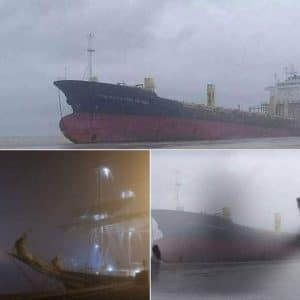In a story straight out of a maritime thriller, a
massive abandoned ship recently washed ashore near Burma’s bustling city of
Rangoon, leaving authorities and locals baffled. Dubbed a "ghost
ship," the rusted vessel, identified as the Sam Ratulangi PB 1600,
carried no crew, no cargo, and no clear answers about how it came to drift
aimlessly across the seas for years.
The discovery has sparked global intrigue and a wave
of speculation, as investigators work to unravel the ship’s enigmatic journey.
What was this ship’s purpose? Why was it abandoned? And what clues might it
hold about the hidden dangers of the shipping industry?
A Haunting Discovery on
Burma’s Shores
Last Thursday, residents of the Thongwa municipality
were the first to spot the colossal ship drifting eerily near the coast. Images
quickly surfaced on social media, showing the corroded structure of the Sam
Ratulangi PB 1600, a vessel that once stood tall as a feat of maritime
engineering.
When local authorities boarded the ship, they found it
eerily empty—no crew, no cargo, and no signs of recent activity. However, they
did encounter five fishermen aboard the ship. The fishermen revealed they had
boarded out of curiosity, hoping to explore the vessel and possibly claim
salvage rights under maritime law.
This find marked the first chapter in what has become
a captivating mystery.
The Ship’s Identity: What We
Know About the Sam Ratulangi PB 1600
The Sam Ratulangi PB 1600, once a formidable
cargo ship, was identified through its markings and registration details. Its
last recorded location was traced to the bustling port of Chittagong in
Bangladesh—famous for its ship-breaking yards, where old vessels are dismantled
for scrap.
Investigators believe the Sam Ratulangi may
have been destined for deconstruction at Chittagong. Each year, hundreds of
vessels meet their end in this thriving industry, where they are stripped for
valuable materials like steel, copper, and aluminum. However, something went
awry in the ship’s journey, leaving it adrift and abandoned on the high seas.
Theories Abound: What
Happened to the Ghost Ship?
The sudden appearance of a massive ghost ship raises
many questions, and theories about its fate have been swirling. Maritime
experts suggest that the ship’s crew may have abandoned it after an accident or
mechanical failure. Without proper navigation or power, the Sam Ratulangi
would have been left at the mercy of ocean currents.
Another plausible theory is linked to the
ship-breaking industry itself. It’s not uncommon for vessels en route to
dismantling yards to encounter legal or logistical challenges. Some are
abandoned due to disputes over ownership or financial difficulties. Could the Sam
Ratulangi have been caught in such a predicament?
Environmental activists have also raised concerns.
They highlight the environmental risks posed by abandoned ships, including oil
leaks and hazardous materials left onboard. These ghost ships often become
floating environmental hazards, threatening marine ecosystems.
The Shadowy World of Ship
Breaking
The Sam Ratulangi PB 1600’s connection to
Chittagong shines a light on the controversial ship-breaking industry. While
this industry plays a crucial role in recycling materials, it is also notorious
for its unsafe working conditions and environmental impact.
Workers at these ship-breaking yards often face
hazardous conditions, dismantling massive vessels by hand with little
protective equipment. Meanwhile, the process releases toxic materials into the
environment, polluting nearby waters and air. The Sam Ratulangi may well
have been another victim of this shadowy trade, abandoned in the chaos of
maritime commerce.
The Global Fascination with
Ghost Ships
This isn't the first time a ghost ship has captured
the world’s imagination. From tales of the Mary Celeste to the
mysterious disappearance of the crew aboard the SS Ourang Medan, ghost
ships have long been a source of intrigue and fear.
The case of the Sam Ratulangi PB 1600 is no
different. Its sudden reappearance serves as a chilling reminder of the untamed
nature of the seas and the countless untold stories they hold.
Ghost ships are rare, but when they do surface, they
often reveal deeper truths about the hidden workings of global industries, the
perils of maritime life, and the environmental toll of human activities.
The Investigation Continues
For now, the Sam Ratulangi PB 1600 remains
under investigation by Burmese authorities. Efforts are underway to trace its
ownership and understand the circumstances of its abandonment. International
maritime agencies may also get involved to address broader concerns about ghost
ships and their impact on global waters.
Meanwhile, the ship itself has become a local
attraction, drawing curious onlookers and sparking debates about the ethics of
modern shipping practices.
A Symbol of Mystery and
Reflection
The haunting image of the Sam Ratulangi PB 1600,
rusting in solitude against the backdrop of Burma’s shores, has become a symbol
of both mystery and reflection. It highlights the complexities of the maritime
world, from its economic importance to its environmental and human cost.
As the story of this ghost ship unfolds, it reminds us of the vast, often unseen network of forces shaping our world. From abandoned vessels to the hidden dangers of industrial practices, the seas remain a realm of secrets waiting to be uncovered.


Post a Comment